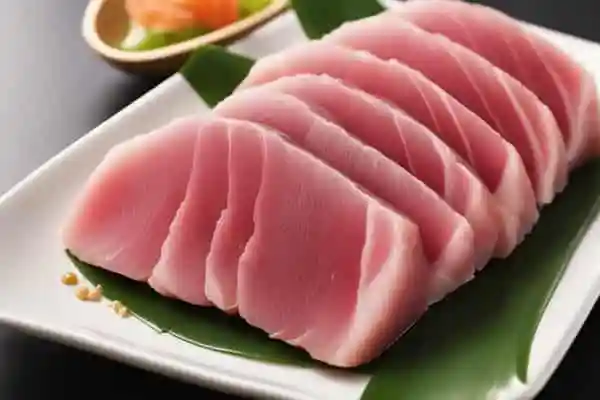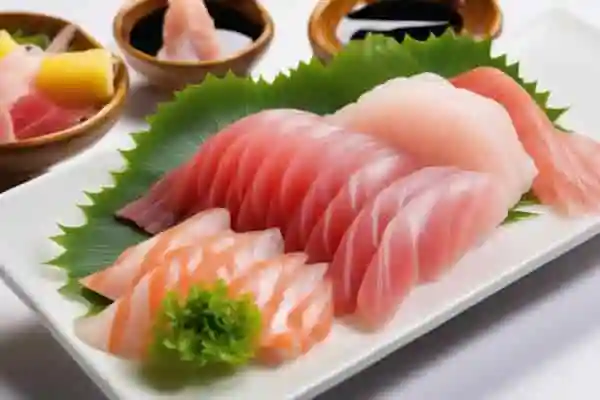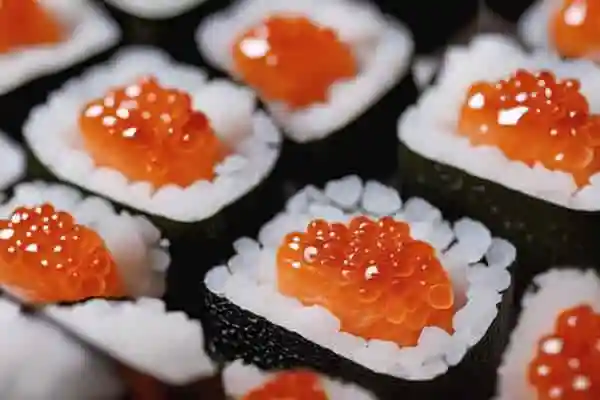Hokkaido Sushi – Hooking Rich Sushi Seas one Bite at a Time
Updated: 12 Aug 2023
184

Hokkaido sushi stands out as a tasty type of Japanese sushi. It comes from Hokkaido, the northernmost island of Japan. The cold oceans around Hokkaido have lots of fresh seafood like salmon, sea urchins, and clams.
Expert sushi chefs carefully pick the freshest catches of the day. They make Hokkaido sushi that brings out the natural, rich flavors of the seafood.
There are also nori maki rolls stuffed with salmon just caught off Hokkaido’s coast. Local vegetables like corn and squash are also used in the sushi.
Hokkaido sushi focuses on fresh local ingredients and easy cooking methods. These let the great taste of the fish come through. The pure flavors of the seafood mirror Hokkaido’s clean oceans and sushi traditions. Kids and adults alike would enjoy the delicious taste of Hokkaido sushi!
Table of Contents
What Makes Hokkaido Sushi Special
Some key things set Hokkaido sushi apart from other types of sushi. These special traits all make eating Hokkaido sushi an awesome experience.
1. Expert Craftsmanship
Making Hokkaido sushi takes expert craftsmanship. Sushi chefs train for years to become pros at slicing fish and shaping nigiri by hand. Their skill makes sure the textures and flavors are just right.
2. Focus on Fresh Ingredients
Only the freshest seafood from Hokkaido’s cold oceans is used. The sushi really brings out the yummy natural tastes of the fish and vegetables.
3. Simple Presentation
With Hokkaido sushi, extra garnishes, and seasoning take a back seat. The sushi looks simple, so the pure flavors can shine through.
The chef’s dedication, fresh local ingredients, and straightforward presentation all make Hokkaido sushi unique and crazy delicious. These key things define what makes Hokkaido sushi so awesome.
Hokkaido’s Amazing Fresh Seafood for Sushi
Hokkaido has tons of fresh seafood for sushi thanks to its cold, clean oceans. The seafood shows off the island’s awesome marine life.
1. Fatty Tuna

Prized toro, or fatty tuna belly, has a smooth, melt-in-your-mouth texture and rich umami taste. This premium tuna is a Hokkaido treasure.
2. Sweet Shrimp
Big pink amaebi shrimp from Hokkaido are famous for their soft sweetness. They often get served as sashimi or nigiri sushi.
3. Sea Urchin
The exclusive uni sea urchin from Funka Bay in Hokkaido is super creamy and briny. It’s a total delicacy.
4. Hokkaido Scallops

Sweet Hokkaido scallops are a specialty. Their tasty ocean flavor adds flavor to sushi and appetizers. Large scallops are hand-shucked fresh daily.
Thanks to pristine waters, people can enjoy these awesome fresh seafood picks through Hokkaido’s awesome sushi.
The Art of Making Nigiri Sushi
Nigiri sushi is an art form that requires careful precision. Hokkaido sushi chefs have mastered nigiri, making it a wonderful experience.
1. Expert Rice Handling
Perfectly seasoned rice gets molded by hand into little pillows. The texture and temperature must be just right for the fish.
2. Fancy Knife Skills
Slicing the fish takes skill, with knives cutting at special angles to get paper-thin, melt-in-your-mouth slices.
3. Balanced Building
The chef tops the rice with the fish, thinking about textures and flavors. The nigiri must look beautiful and balanced.
4. Focus on Freshness
Each step focuses on maintaining the fresh, clean taste of the seafood. The techniques should enhance but not hide the fish’s flavors.
When everything comes together, nigiri sushi becomes a blissful treat. Hokkaido sushi chefs have elevated nigiri to an awesome edible art.
Hokkaido’s Amazing Sashimi

Sashimi means raw seafood sliced into thin pieces. Hokkaido sashimi shows off the island’s incredibly fresh seafood. The sashimi looks as awesome as the nigiri sushi.
1. Slicing Perfection
Good sashimi needs slices cut at specific angles and thicknesses. This gives the best taste and a pretty presentation.
2. Optimal Freshness
Only the freshest seafood gets used, and prepared within hours of being caught. Top freshness is key to great sashimi.
3. Local Selections
Local shrimp, scallops, and more shine when served in simple, perfect slices.
4. Ideal Accents
Delicate garnishes like ginger, wasabi, and soy sauce enhance the seafood.
The pure joy of the freshest seafood comes through in Hokkaido’s amazing sashimi. The slicing methods and fresh picks come together with excellence.
Fun and active Maki Varieties
1. Fun Creative Maki Rolls
Along with nigiri and sashimi, Hokkaido sushi restaurants make creative maki rolls using local flavors.
2. Salmon Roe Gunkan Maki

Classic gunkan sushi cradles juicy salmon roe from Hokkaido, giving a pop of briny taste per bite.
3. Snow Crab Rolls
Sweet shredded Hokkaido snow crab meat stars in these special maki rolls.
4. Slim Scallop Rolls
Thin hosomaki rolls wrapped in nori seaweed highlight plump Hokkaido scallops.
5. Local Vegetable Rolls
Rolls with Hokkaido corn, radish, and other fresh-picked vegetables.
With cool presentations and seafood/produce combos, these maki rolls offer new and dynamic ways to enjoy Hokkaido’s flavors.
Yummy Vegetarian Hokkaido Sushi
While seafood is popular, Hokkaido sushi also has creative veggie options using local produce. These offer fresh flavors without fish.
1. Veggie Maki Rolls

Colorful rolls packed with Hokkaido carrots, cucumbers, avocado, and pickled radish excite vegetarians with crunch.
2. Natto Nigiri
Fermented soybeans give a unique Japanese comfort food taste atop sushi rice for a satisfying nigiri.
3. Crispy Tofu Rolls
Tofu katsu, or crispy fried tofu, adds a tasty crunch to rolls paired with veggies or avocado.
4. Corn Tempura
Sweet Hokkaido corn fried in a light tempura batter makes a fun finger food and seasonal treat.
Hokkaido sushi celebrates both seafood and the region’s plentiful crops. Vegetarians can enjoy Hokkaido’s spirit through fresh, tasty sushi options.
Hokkaido Sushi’s Unique Fusion Dishes
While respecting tradition, Hokkaido sushi chefs also make unique fusion dishes, blending global flavors with Japanese ones.
1. Truffle Salmon Nigiri

Fancy salmon nigiri gets drizzled with truffle-infused soy sauce for an extra rich umami taste.
2. Caramelized Onion Gunkan
Sweet caramelized onions put a modern twist on a gunkan bed of sushi rice.
3. Crispy, Spicy Tuna Rolls
Spicy tuna gets a crispy coating of tempura crumbs for an indulgent texture.
4. Mango Scallop Salsa
Tropical mango salsa gives a sweet, fruity kick to tender Hokkaido scallops.
These creative fusions expand Hokkaido’s sushi possibilities. Every bite offers both tradition and new twists.
Hokkaido Sushi’s Omakase Experience
The ultimate way to enjoy Hokkaido sushi is through an Omakase experience. Omakase means “leave it to you” – diners trust the chef’s mastery.
1. Seasonal Ingredients
The chef makes a special tasting menu using the freshest seasonal ingredients, like spring bamboo shoots or summer corn.
2. Element of Surprise
Part of the fun is not knowing what comes next. The chef takes you on a journey of flavors you couldn’t imagine yourself.
3. Personalized Attention
Omakase is a personalized meal. The chef picks foods based on what each diner seems to like.
4. Ultimate Indulgence
From silky Hokkaido uni to toro that melts in your mouth, omakase diners get the best and rarest choices.
By trusting the chef, omakase unlocks Hokkaido sushi’s full awesome potential. This ultimate experience creates long-lasting memories.
Enjoying Hokkaido’s Amazing Sushi
- Hokkaido, the northern island of Japan, is a dream for sushi fans. The freezing seas around it have tons of pristine seafood.
- Expert Hokkaido sushi chefs turn this seafood into edible art. From hand-shaped nigiri to artsy rolls, Hokkaido sushi is an adventure for your senses.
- The key to amazing Hokkaido sushi is the fresh, seasonal seafood from the cold local waters. Fatty tuna belly, sweet shrimp, creamy sea urchins, and more showcase the fantastic local ocean life.
- Chefs use decade-old skills to slice, drape, roll, and present the seafood to highlight its natural glory.
- Taking care of the sushi rice is equally important. Perfectly seasoned rice at the ideal temperature lifts the seafood flavors.
- The fish and rice work together to make each piece delicious.
- From classic nigiri and sashimi to creative new fusions, Hokkaido sushi has diverse flavors and textures to try.
Enjoying this regional sushi is a really memorable tasting adventure.
Where to Find Authentic Hokkaido Sushi
- Craving the fantastic sushi of Hokkaido but can’t go to Japan? Luckily, some great Hokkaido sushi restaurants are bringing the real experience to cities worldwide.
- At these restaurants, skilled sushi chefs from Hokkaido make traditional recipes just like back home. They use many imported ingredients from Hokkaido’s clean waters.
- The focus is on real Hokkaido methods and flavors, from vinegared rice to knife skills for slicing flawless sashimi.
- The restaurants highlight Hokkaido classics like hosomaki rolls, salmon roe nigiri, and delicate sashimi platters. Seasonal seafood stars.
- Dining spaces aim to recreate Hokkaido’s calm, modern look.
- For sushi fans who want to taste Hokkaido outside Japan, these authentic restaurants provide a fantastic sushi experience.
- Read on to find top spots bringing the excellence of Hokkaido sushi to a city near you!
Mastering Making Hokkaido Sushi at Home
- While eating Hokkaido sushi at a restaurant is best, it’s possible to make tasty Hokkaido-style sushi at home with practice.
- Preparing those fancy pieces starts with getting ultra-fresh seafood and learning traditional methods.
- The key is quality Hokkaido-inspired ingredients like fresh salmon, shrimp, avocado, and real crab meat if you can find them. A sharp sushi knife and bamboo rolling mat are also essential tools.
- Once you have great fish and rice, proper slicing, rolling, shaping, and garnishing techniques help achieve authentic Hokkaido essence.
- Our step-by-step guide will walk you through making nigiri, hosomaki, and other Hokkaido specialties.
- Making restaurant-quality Hokkaido sushi takes dedication, but serving these creations at home is rewarding.
- Let’s master this edible art together, one piece of nigiri at a time!
The Myths Around Sushi, Debunked
- Sushi is raw fish – False! Many vegetarian sushi rolls feature cooked or fresh veggies.
- Sushi rice has lots of added sugar – Not true! Only a modest amount of sugar seasons the vinegar and salt dressing.
- Sushi is unhealthy – Actually, high-quality ingredients like omega-3 fish and veggies make it nutritious.
- Sushi is only basic rolls – Beyond rolls like California & dynamite, there’s elegant nigiri, layered chirashi & seaweed temaki too.
- Sushi remains a mystery – By understanding the core ingredients and different types, sushi’s diversity of flavors and forms comes alive!
Let’s forget the myths and dive into sushi’s wonderful nourishing world for ourselves!
The One-of-a-Kind Umami Punch in Hokkaido Sushi
- Hokkaido sushi adds a special type of kelp to amplify the rich, savory taste of umami beyond other regions.
- Outstanding umami comes from local delicacies like hairy crab and salmon roe only found on Japan’s northern island.
- Traditional Hokkaido aging and vinegar dressing infuses the sushi rice with rare umami depth straight from the source.
- Biting into fatty bluefin tuna or creamy sea urchin nigiri from Hokkaido floods your senses with intense, tongue-coating umami.
- Mastering the art of maximizing umami gives Hokkaido sushi its craveable, melt-in-your-mouth distinction.
Final Words
Nestled on Japan’s northern frontier, Hokkaido’s frigid waters and rich kelp forests breed premium seafood with intensely umami flavors found nowhere else.
Local master chefs then amplify this one-of-a-kind ingredient quality through specialized aging methods and region-specific rice vinegar.
The result is Hokkaido sushi with a truly singular personality – think melty salmon roe nigiri, seared hairy crab rolls, and succulent bluefin tuna temaki that flood the palate with its namesake prefecture in every bite.
Let your tastebuds discover what perfect technique and remote terroir can create in this northern island’s show-stopping sushi.
FAQs
What is Minato sushi?
Minato sushi is a type of sushi from the port city of Minato in Tokyo, Japan. It’s known for fresh seafood like tuna and seasonal ingredients.
What is a sushi restaurant called in Japan?
Sushi restaurants in Japan are called sushi-ya. The chef is the itamae. Many fancy sushi-ya offer omakase-tasting menus.
Is sushi from Japan?
Yes, sushi began in Japan as a way to preserve raw fish with rice and vinegar. The traditional method was nare-zushi which evolved into edo-make sushi in Tokyo.
What is Uzumaki vs. Maki?
Uzumaki has rice on the outside, while maki has seaweed outside and rice inside. Uzumaki gives reversed textures.
Why is sushi called sushi?
Sushi was first known as nare-zushi. The word “sushi” means sour, from the sour vinegar used to ferment the rice and preserve the fish.
What is the opposite of omakase?
The opposite of omakase is okonomi, meaning “what you like” in Japanese. Diners pick exactly what they want.
Why is omakase so expensive?
Omakase is pricey because you pay for the chef’s skill in picking the best fish, techniques, and presentations. Rare ingredients also cost more.
Why is Omakase so good?
Omakase is incredible because the chef makes carefully planned courses with the highest quality ingredients and masterful skills.
Do Japanese eat sushi every day?
No, most Japanese enjoy sushi occasionally or as a special treat rather than daily since it takes much skill to prepare.
What is the national food of Japan?
The national food of Japan is rice since it’s been grown for centuries and forms the base of Japanese cuisine, including sushi.
Please Write Your Comments